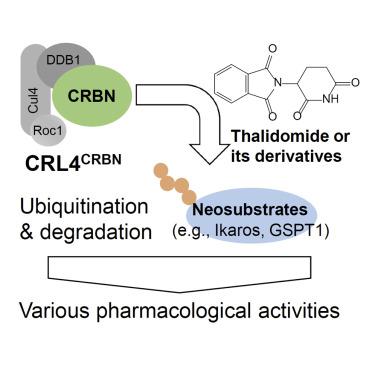Cell Chemical Biology ( IF 6.6 ) Pub Date : 2021-05-24 , DOI: 10.1016/j.chembiol.2021.04.012 Takumi Ito 1 , Yuki Yamaguchi 2 , Hiroshi Handa 1

|
Cereblon (CRBN), originally identified as a gene associated with intellectual disability, was identified as primary target of thalidomide. Accumulating evidence has shown that CRBN is a substrate receptor of Cullin Ring E3 ubiquitin ligase 4 (CRL4) containing DDB1, CUL4, and RBX1, which recognizes specific neosubstrates in the presence of thalidomide or its analogs and induces their ubiquitination and proteasomal degradation. A set of small-molecule, CRBN-binding drugs are known as molecular glue degraders because these compounds promote the interaction between CRBN and its neosubstrates. Moreover, CRBN-based proteolysis-targeting chimeras, heterobifunctional molecules hijacking CRBN and inducing degradation of proteins of interest, have emerged as a promising modality in drug development and are being actively investigated. Meanwhile, the original functions and regulations of CRBN are still largely elusive. In this review, we describe key findings surrounding CRBN since its discovery and then discuss a few unanswered issues.
中文翻译:

在医学和化学生物学中利用泛素连接酶 cereblon 作为小分子化合物的靶点
Cereblon (CRBN) 最初被确定为与智力障碍相关的基因,被确定为沙利度胺的主要靶点。越来越多的证据表明,CRBN 是包含 DDB1、CUL4 和 RBX1 的库林环 E3 泛素连接酶 4 (CRL4) 的底物受体,它在沙利度胺或其类似物存在的情况下识别特定的新底物并诱导它们的泛素化和蛋白酶体降解。一组小分子、CRBN 结合药物被称为分子胶降解剂,因为这些化合物促进 CRBN 与其新底物之间的相互作用。此外,基于 CRBN 的蛋白水解靶向嵌合体、异源双功能分子劫持 CRBN 并诱导感兴趣的蛋白质降解,已成为药物开发中一种有前途的方式,并正在积极研究中。同时,CRBN 的原始功能和规定在很大程度上仍然难以捉摸。在这篇综述中,我们描述了 CRBN 自发现以来的主要发现,然后讨论了一些悬而未决的问题。











































 京公网安备 11010802027423号
京公网安备 11010802027423号